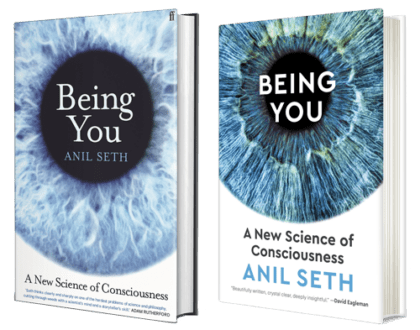
At various times while reading Anil Seth’s engaging and accessible Being You, I was reminded of the people in Helen Thomson’s Unthinkable, the subject of a previous blog post. Thomson was documenting the distinct experiences of people whose perception of themselves and/or the world around them depart substantially from what is typical: people who think they are tigers or dead or who can have their orientation to the world flipped instantaneously. Seth is giving an account more generally of why perception works the way it does, and so I found myself regularly wondering if his model accounts for the full breadth of perceptual experience. That is a testament both to how memorable Thomson’s accounts were and to how compelling Seth’s writing is that I believed his model probably could.
However, that may not be entirely complimentary to Being You. At some point one has to ask the reverse question of whether there are any possible perceptual experiences that wouldn’t be consistent with Seth’s model. For that I suppose we need to talk about the details. The first section of the book discusses measures of consciousness. These are not unique to Seth’s way of thinking about consciousness; he is just surveying contemporary approaches to generating objective assessments that correlates with subjective reports. The immediate application is deciding challenging end-of-life questions; however, I believe here the main point is more about establishing that consciousness is a brain function rather than some nonphysical mind of the Cartesian persuasion. René Descartes comes up regularly as a foil. I’m not sure Seth is going to convert any committed Cartesian dualists or even that he needs to refute Cartesian dualism for his model to work, but it is clearly on his mind. Alternatively, the main point may simply be that since we can measure consciousness, we can establish it as something which humans possess while bacteria and rocks do not.
The second section deals with perception; having established that we are conscious, what is it we are conscious of? Here is where I think Seth’s view is concretely distinct from alternatives. The central idea is that our minds make predictions about our sensory inputs, or the causes of our sensory inputs, and what we perceive are these predictions rather the sensory inputs themselves. He proposes specifically a Bayesian model for these predictions, although I suspect you could put together a similar proposal with other prediction schemes. Under the Bayesian framework, we have some preexisting (prior) expectations for our sensory input which gets reconciled with new sensory data for an updated (posterior) prediction that becomes the prior for the next iteration. The degree to which new data update the prior can be adjusted.
That our perception is something other than raw sensory data seems incontrovertible. Just think of the infamous blue and black dress which some perceived as white and gold. Seth discusses that example and offers an explanation for the varying experiences in terms of different priors about lighting conditions (indoor fluorescents vs outdoor daylight) and how well they align with the actual lighting in the photo. Adelson’s checkerboard illusion is also cited, as is the popular video of a basketball passing drill. Perhaps you have your own favorite optical or perceptual illusion. We know our perception is not infallible; the Bayesian prediction framework seems to make sense of many of the specific ways our senses lead us astray. Then again, maybe it is just giving a different name to the deviation between external reality and internal experience.

In the third section, Seth takes up questions around our sense of self. He accounts for these as perceptions–in the same Bayesian prediction sense–of our body’s internal states and of our perceptual processes themselves. Again, some of amount of this is fairly inarguable and not distinctive to Seth’s model. We know for example that what we experience as emotions are connected to sensory input of our physiological conditions. Seth is able to narrate this understanding in the language of Bayesian predictions, and it makes for compelling accounts, but I suspect a lot of it would be true regardless of how perception works. Similarly, framing our identity, our sense that there is an “I” experiencing all of these perceptions, as our perceptual processes perceiving themselves, can be done independent of how perception works. This seems to me as essentially what Douglas Hofstadter has suggested in I Am a Strange Loop, for example, albeit with fewer neurological details.
Thus I think, although I could be mistaken, that there are really two ideas here, either of which could be true without the other. One is that our perceptual experiences are top-down Bayesian predictions about our sensory data. The other is that every facet of our conscious experience is perception all the way down, varying only in the source of the sensory data and the types of predictions we attempt to make about them. Personally, I find both ideas attractive, but I think it is worth highlighting their separability because I don’t believe Seth made that clear himself.
Part of what attracts me is the tractability. I understand Bayesian inference and so I at least feel like I can understand consciousness in a richer and more detailed way with a model like that. Of course, tractability doesn’t guarantee truth. I may simply have a bias in my priors towards tractable models. I can argue that bias is Biblical; if God created the world and if God created us to exercise dominion over that world, there is an implication that we were created with the capacity to understand the world in order to exercise that dominion. Thus whatever is true about how the world works should be comprehensible, if not to me specifically then to people in general. Still, even a Biblically motivated bias isn’t always guaranteed to be right.
Last month, I wrote about the Doctor Strange film and talked about my difficulties engaging with magic. That’s basically the flip side of the bias towards tractability. To be honest, I come up against similar issues with concepts like ‘soul’ and ‘spirit’. I know I was given definitions in school and probably sermons, but they never seem to stick. I don’t know how to know how a soul works–or doesn’t work. Sure, that could be a ‘me’ problem, some kind of cognitive blind spot. But if that is the case, a Bayesian perceptual framework suggests a way for dealing with that kind of blind spot, by updating my priors. That could work, or it could not, which would help me to know if that’s the correct model for how my conscious mind works.
Andy has worn many hats in his life. He knows this is a dreadfully clichéd notion, but since it is also literally true he uses it anyway. Among his current metaphorical hats: husband of one wife, father of two teenagers, reader of science fiction and science fact, enthusiast of contemporary symphonic music, and chief science officer. Previous metaphorical hats include: comp bio postdoc, molecular biology grad student, InterVarsity chapter president (that one came with a literal hat), music store clerk, house painter, and mosquito trapper. Among his more unique literal hats: British bobby, captain’s hats (of varying levels of authenticity) of several specific vessels, a deerstalker from 221B Baker St, and a railroad engineer’s cap. His monthly Science in Review is drawn from his weekly Science Corner posts — Wednesdays, 8am (Eastern) on the Emerging Scholars Network Blog. His book Faith across the Multiverse is available from Hendrickson.

Leave a Reply